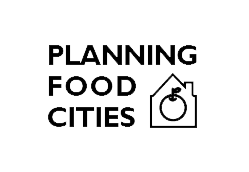Sustain • Planning Food Cities
For planners
Sustain encourages local planning authorities to use their planning powers to support community food growing and access to food through the mechanisms of plan-making and decision-taking, neighbourhood and area planning and by publishing planning guidance.
Building healthy places with walkable streets, safe homes, access to healthy food, and publicly accessible amenities need not be an additional line on a development’s cost sheet. Many cost-effective healthy design measures are features of good design that not only benefit health and well-being, but also create better places with higher commercial value and lower environmental impact. RICS Insight Paper Cities, health and well-being 2018
Mechanisms for planning healthy food
- Local Plan policy
- Design codes and guidance
- Supplementary Planning Documents (Sustainable Development, Healthy Communities, Town Centres, Public Realm etc)
- Masterplans
- Health Impact Assessments
- Conditional approvals
- Informatives to planning consents
Policies for a good food environment
Planning policies to achieve a sustainable food system would cover the following topics (encouraging or restricting, as appropriate):
Food growing and production
Allotments
Community gardens
Private amenity space
Edible landscaping (also applies to public realm)
Agricultural/horticultural land and soil
Intensive animal agriculture
Green Belt and peri-urban land use for soil based market gardens.
Food Economy
Growing enterprises / food production
Infrastructure (local processing, storage, abattoirs, wholesalers, markets, food hubs.)
Access to healthier food through retail
Markets
Hot food takeaways
Farm shops
Community / local shops
Restaurants and cafes with or without outdoor sitting areas
Access to healthier food in the home, at school or at work
Internal residential or workplace standards for food storage, kitchens and dining.
Access to healthier food in the Public Realm
Drinking water fountains, outdoor dining/food courts
(Food and Drink) Advertisements
Edible landscaping
Accessible neighbourhoods (local shops, active travel, public transport)
Menu
- How community food growing contributes to strategic objectives
- Local Plan policies for community food growing
- Design Quality and Access to Healthier Food
- Food and Healthy Communities
- Hot food Takeaways
- Public Realm
- What are food systems?
- Development Management policies for a good food environment
- Evidence
How community food growing contributes to strategic objectives
Harness the strategic benefits of community food growing as part of your green infrastructure
In this section we will look at the benefits of community food growing to meeting key strategic objectives for sustainability, health and wellbeing, education, skills and enterprise, regeneration and good design. We draw on Sustain’s work with planners and examples of planning practice.
Sustainability
Community food growing spaces contribute to achieving policies on mitigating and adapting to the effects of climate change and other sustainability priorities. Urban food growing spaces help achieve sustainable development in the following ways:
- locally grown food reduces food miles and improves air quality;
- adaptation to the impacts of Climate change – for example flood alleviation and cooling urban heat islands;
- permeable surfaces of food growing spaces and the harvesting of rainwater contribute to sustainable drainage; and
- green roofs provide accessible open space in high-density development.
Carbon emissions
Food systems account for up to 1/3 of global greenhouse gas emissions and are at the heart of the biggest challenges we are facing including biodiversity loss and escalating levels of obesity.
The UK will not reach its commitment to Net Zero by 2050 without transforming how land is used and reducing food waste and consumption of the most carbon-intensive foods.
Local planning authorities have a crucial role to play. Our Every Mouthful Counts toolkit contains actions for councils to tackle the climate and nature emergency through food.
Planning for the Planet is a voluntary commitment that councils can make to signal leadership on environmental issues. A guide has been developed alongside planning experts and is designed to provide council officers with everything they need to implement the Planning for the Planet commitment. Actions for the planning service could include:
- Publish and maintain a map of council landholdings
- Use planning policy to protect food growing
- Increase the amount of land used for local food growing and production
- Transition farms in your area to agroecology
- Create a planning designation for assets of value to farming, producing, transporting and selling sustainable food
Health and wellbeing
The activity of growing food offers people the chance
- to take exercise,
- socialise,
- reduce stress
- access fresh and healthy fruit and vegetables.
A Kings Fund / National Gardens Scheme report on the health benefits of gardens and gardening makes suggestions for Local Government including:
Assessing demand for allotments and – where appropriate and locally supported –reducing the plot size to create opportunities for more people to experiment with growing their own food.
Supporting the use of excess and low quality public land and space as community gardening schemes.
Prioritising in planning developments access to green space – particularly for lower socio-economic groups eg space to grow food on roofs, communal gardens, or allotments.
Education, skills and enterprise
Small-scale community food growing and urban agriculture projects can encourage the growth of the local food economy and develop skills and the improved employability amongst participants.
Community food growing spaces
- provide a learning environment,
- develop transferable skills that increase skills and employability.
- encouraging enterprising activity,
- create viable social enterprises selling to local businesses or directly to the consumer.
Regeneration and community development
Community food growing spaces
- foster community cohesion and inclusion
- improving the local area and contributing to successful regeneration.
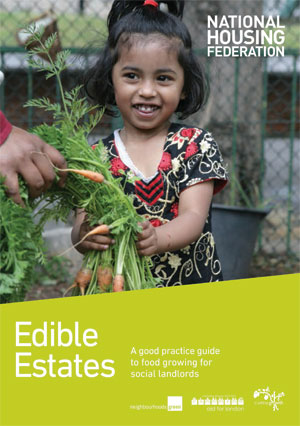 Community food growing and social housing
Community food growing and social housing
Neighbourhoods Green, Capital Growth and Planning Aid for London have published shared learning and good practice from communities and social landlords who have been involved in food growing initiatives on social housing owned land. The publication offers practical ideas to support those working for or with housing providers in collaboration with local people, to establish food growing schemes.
Edible estates, (2014) Neighbourhoods Green, The National Housing Federation
Design and residential amenity
The National Design Guide for England sets a baseline standard of quality and practice which local planning authorities are expected to take into account when developing local design codes and guides and when determining planning applications. It states well-designed places "provide attractive open spaces in locations that are easy to access, with activities for all to enjoy, such as ..food production, .. so as to encourage physical activity and promote health, well-being and social inclusion."
Together with the accompanying Guidance Notes, the following elements of good design relating to the food system are highlighted :
- Private and communal open space design
- Allotments and community growing: need to consider community growing projects for food production, learning and community engagement on large developments.
- Inclusion of communal open spaces in new developments to promote the health and wellbeing of residents
- Local shops: The design code needs to provide guidance for the design of and access to local shopping facilities.
- Principles of Public Space Design with provision for markets which are as focal points at the heart of the community.
The Building Research Establishment’s Home Quality Mark (HQM) awards credits for having growing space accessible to new homes. http://homequalitymark.com During master-planning, BREEAM Communities encourages the early thought of community spaces, including allotments, to help bring communities together. http://www.breeam.com/communities. The Home Quality Mark (HQM) is a national standard for new homes, which helps provide information on a new home’s design, construction quality and running costs. It also shows the impact of the home on the occupant’s health and wellbeing. HQM provides consumers with an indication of the quality of living space as well as local amenity.
Local Plan policies for community food growing
A guide for planners brings together in one place examples of planning policies around the UK that support community food growing. It is aimed primarily at planning authorities to help them to use food growing as a way of creating healthy communities.
Dr Hugh Ellis, Town and Country Planning Association, in his foreword to the guide said,
“Truly sustainable development can deliver multiple benefits such as social housing, zero carbon design, sustainable transport and local food sourcing, and this report puts community food growing into this mix, showing how more planning authorities could easily be following suit and making this standard practice in their plan making and decision taking.”
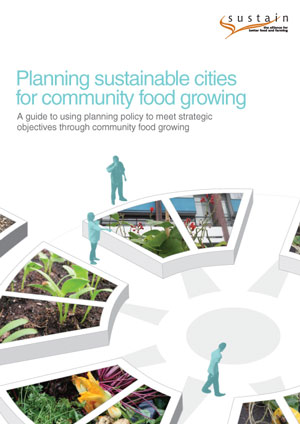 The guide helps planners to support the provision of space for food growing as part of building a healthy community.
The guide helps planners to support the provision of space for food growing as part of building a healthy community.
The range of strategic objectives that community food growing contributes to are highlighted and are illustrated with examples of planning policies and decisions, and projects, to show why and how to provide more food growing spaces.
The report’s recommendations for planners include the adoption of a strategic policy that supports food growing, to protect existing community food growing spaces and provide new ones. And, that planners should influence provision of food growing space in new developments by setting targets for the amount of space to be provided. The report shows that such pioneering planning guidance in Brighton & Hove has resulted in over one third of new developments now incorporating community food growing.
* The National Planning Policy Framework in England has been updated since this report was published.
Following a survey of Americal planners, this article looks at how local governments in the US can remove public policy barriers to locally grown food.
Urban Agriculture and Community Engagement in policies and plans: Key questions explored in this journal are how communities are engaging in urban food policy making and planning and how local governments are responding to community demands for food policies and plans.
Design Quality and Access to Healthier Food
Housing
Internal layout - Provision of adequate kitchen and dining facilities with space to store food and to prepare & cook fresh food.
People need space to cook and space to sit and share meal times; this is as crucial part of designing for healthy communities, as adequate sleeping space.
These facilities provide for families looking to avoid food poverty or dependency on takeaway food, which by its very nature tends to be unhealthier is also disempowering.
Planners can work with developers on best practice for inclusion in masterplans and garden village plans. Encourage take up through BRE Home Quality Mark, initiatives with social landlords.
External layout - Incorporate communal gardens or individual plots to enable food growing as part of the landscape design of the amenity open space of a development
Identify in any landscaping proposal where food growing spaces, productive trees, other edible planting, together with structures needed to facilitate food growing, such as storage for tools and equipment, water supply, irrigation, water butts can be integrated as part of a cohesive design of the development as a whole.
Compile management and maintenance plans to ensure spaces will be managed successfully once the development is handed over. It is good practice to specify having onsite support to start the project.
Public Buildings
Education and childcare facilities - adequate provision of kitchen, dining, and food growing space, alongside easy access to tap water.
Having infrastructure in place enables healthy food provision.
- Ensures a high standard of Health and education of children, staff and families.
- Children remain in schools at lunchtime.
- Reduction in demand reduces proliferation of outlets selling junk food near schools.
- Addresses the challenge of childhood obesity.
Hospitals - Staff rooms with food heating & storage
Provision of adequate kitchen facilities, including kitchens on every ward allows fresh food preparation for patients and staff, including communal space for patients to eat together. Hospital staff working night shift are already vulnerable to disease eg heart attacks. Lack of access to healthy food when catering is closed compounds their unhealthy lifestyle. Healthier, happier patients recover more quickly
In all healthcare settings, including hospitals, GP practices, and care homes – consideration should be given for food growing and fresh food retail facilities to benefit patients, staff and visitors
Food and Healthy Communities
Food growing for health and wellbeing
Growing Health, a national project run by Garden Organic and Sustain, funded by the Tudor Trust, looked at how community food growing can be routinely used by the health and social care services as a way of promoting health and wellbeing for a range of individuals and population groups.
Reuniting health and planning
The TCPA has been leading a series of initiatives to reunite the public health and planning professions to create healthier, happier communities and places. See details of recent and ongoing projects and publications.
The RTPI’s Planning Horizons project examines the vital role that planning can play in delivering improvements to health. Its report published in 2014 includes access to food and urban agriculture.
Development Guidelines - Food environment
The TCPA’s Practical Guide 8 “Creating health promoting environments” https://www.tcpa.org.uk/tcpa-practical-guides-guide-8-health sets out the scope of opportunities for ambitious councils who want to create high-quality, large-scale new developments. It advocates those undertaking new developments should consider the food environment (food retail and food growing) as one element of good place-making. This Practical Guide also suggests tools and mechanisms for delivery and implementation which can be adopted by local authorities and delivery partners. Development guidelines for the food environment are:
Food retail
- Local authority policies to avoid over-concentration of hot-food takeaways and to restrict their proximity to schools, town centres or other facilities aimed at children, young people, and families.
- Consideration of using PHE’s Healthier Catering Guidance for Different Types of Businesses publication (available at https://www.gov.uk/ government/publications/encouraginghealthier-out-of-home-food-provision) to support work with existing businesses to improve healthy catering options.
- Shops/markets that sell a diverse offer of food choices and are easily accessible by walking, cycling or using public transport.
- Leisure centres, workplaces, schools and hospitals with catering facilities that have a healthy food offer for staff, students, and/or customers.
- Exploration of opportunities to support innovative approaches to healthy eating through temporary changes of use.
Food Growing
- Development that maintains or enhances opportunities for growing food and prevents the loss of food-growing spaces, including the provision of community orchards.
- Opportunities for households to own or have access to space to grow food, for example in roof or communal gardens and allotments.
- Protection of the best and most versatile agricultural land on the urban fringe and encouragement for its use for food production.
Hot food takeaways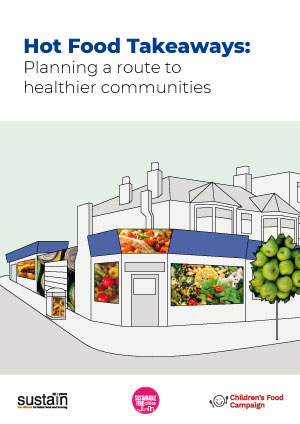
This report explores one way that planning can help improve access to healthier food that has gained traction in the last five years: control of new hot food takeaways. We have looked at how councils across England are using their planning powers to tackle the predominance of hot food takeaways and have heard from planners and their public health colleagues on the challenges of tackling long term health issues. We have compiled case studies of councils that have taken a range of approaches explained in more detail in supplementary planning documents (SPDs).
Hot Food Takeaways: Planning a route to healthier communities
A carefully considered Inspectors report covering hot food takeaway use in Gateshead (2020) looks at
• the effect of the proposed development on the health of the local community in respect of the availability of unhealthy food; and
• whether the health effects of the proposal have been properly assessed.
Good Food Retail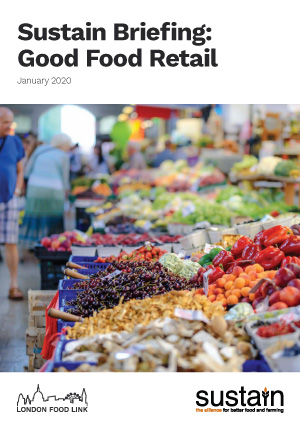
This briefing shows how ‘good food’ works in a retail setting and the types of venues and operations this would apply to.
https://www.sustainweb.org/publications/good_food_retail/
Food deserts are found in areas of high deprivation where there is a risk of food poverty and of overweight and obesity. PHE advise “A good mix of food ‘spaces’ within a local community can offer opportunities for local populations to access healthy foods.
https://www.gov.uk/government/publications/healthy-high-streets-good-place-making-in-an-urban-setting
Public Realm
Drinking water fountains
Drinking water fountains meet local health and environmental / waste priorities
- Provision of healthier alternatives to sugary drinks.
- Reduction of single use plastic bottles.
Consider locating through new development in:
- Transport hubs – helping people access drinking water on the go.
- Shopping precincts and centres – these are high footfall spaces where a fountain can reduce bottled water purchases.
- New developments – where community facilities can be securely accessed.
Funding for installation could be achieved through developer contributions. A clear plan should be in place for ongoing running, maintenance and repair costs.
Planning tools
- Local Plan policies for the public realm.
- Supplementary Planning Documents (SPD) eg urban design, public realm, town centres or healthy communities.
- Masterplans or design guidance for major development sites involving public or publicly accessible space.
- Town centre strategies.
- Specifications for street furniture.
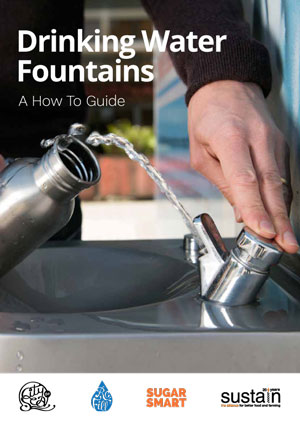 Two organisations, Refill (City to Sea) and SUGAR SMART (Sustain) have produced a toolkit to respond to increasing local demand for guidance on the provision of new drinking water fountains across the UK.
Two organisations, Refill (City to Sea) and SUGAR SMART (Sustain) have produced a toolkit to respond to increasing local demand for guidance on the provision of new drinking water fountains across the UK.
The toolkit pulls together examples of fountains that have been installed in a variety of settings, including schools, parks, community and youth groups, along with indicative costings. The toolkit is a guide to the practicalities of installation, links and recommendations to those who can help, as well as guidelines that need to be met.
www.sustainweb.org/publications/drinking_water_fountains/
Edible Landscaping
Edible landscaping is the use of food producing plants where ornamental plants might have been used. This approach is suitable at a landscape scale for major developments and in the public realm. Green networks could become edible routes through the cumulative contribution of new development choosing productive trees and plants in their landscaping schemes. Such planting could be within development site boundaries or in the public realm.
Edible landscaping
- embraces the public’s engagement with food and the environment
- raises awareness of food and makes it publicly accessible and available
- turns scrumping into foraging
- provides major sustainability benefits such as water management, carbon capture, reduction of air pollution, barriers to pollution
- diversifies habitats and increases food sources for wildlife providing a higher level of biodiversity than in many open spaces.
Market Stalls
Markets provide a sense of place, contribute to independent retailing, local employment and business start-up opportunities. They offer local access to fresh produce often for households that cannot afford or access food required for a healthy diet. Designs for the public realm could incorporate locations for mobile shops or market stall pitches in areas of otherwise poor access to food stores.
Advertisements
When considering applications for planning permission and advertising consent for telephone kiosks:
Consider the health implications of advertisements on telephone boxes especially applications for telephone boxes that are within 400 metres of schools (in line with hot food takeaway guidance).
Consider the adverse effect on amenity in the public realm. If there are no grounds for refusal, consider attaching an informative note to the planning consent. This could point out local public health initiatives and request the avoidance of unhealthy images.
The definition of “amenity” could encompass impacts on healthy communities. The over concentration of street level advertising results in high streets with poor environmental quality and a detrimental effect on public health due to visual clutter and images promoting poor quality food. People trying to avoid obesity are assailed by adverts for junk food; parents suffer pester power from children responding to images; street clutter increases stress levels.
https://www.sustainweb.org/news/apr19_takedownjunkads_report/
What are food systems?
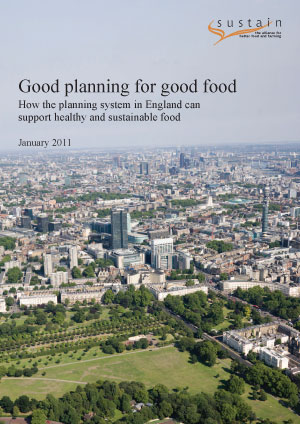 Sustain has looked at how the planning system in England can support healthy and sustainable food. A 2011 report explores how local authorities and communities can use planning policy and decisions to create more local and sustainable food systems. (References a subsequently superceded national planning policy framework). There are a number of ways planners and associated professionals could help create a more sustainable food and farming system. For example, they can:
Sustain has looked at how the planning system in England can support healthy and sustainable food. A 2011 report explores how local authorities and communities can use planning policy and decisions to create more local and sustainable food systems. (References a subsequently superceded national planning policy framework). There are a number of ways planners and associated professionals could help create a more sustainable food and farming system. For example, they can:
- Protect and increase both the number and the diversity of types of food retail outlets – such as small shops and markets - locally, and within easy walking distance of communities, or by public transport.
- Create and protect food growing spaces in and around a locality. Allotments, community growing spaces and a range of other under-utilised public and private space could be used to increase the availability of healthy and sustainable food by expanding the space allocated for food growing. Such spaces can also enhance the quality of productive green spaces in neighbourhoods thereby contributing to biodiversity.
- Discourage food waste, and stimulate productive and/or environmentally benign ways of using unavoidable food waste.
- Support jobs in the food and farming sector by encouraging small- and medium-sized food enterprises (SMEs), such as markets and on-site farm shops, and local and regional distribution infrastructure.
Good planning for good food - using planning policy for local and sustainable food
Development Management policies for a good food environment
In response to government consultation on reforms to the Englsh planning system, Sustain published a suite of development management policies which, if applied as national policies, would set a planning framework for a good food environment. The policies can be adapted and applied by local planning authorities based on the issues relevant to their local areas through current local plan reviews.
Evidence
Healthy weight environments: using the planning system
PHE explain how local authorities' public health and planning teams can promote healthy weight environments in this 2020 guidance. Sections cover hot food takeaways, healthier catering and food growing.
Practical support for local authorities that wish to use the planning system to achieve these important public health outcomes. Set in the context of a whole systems approach to tackling obesity, this document provides a framework and starting point for local authorities to clearly set out in local planning guidance how best to achieve healthy weight environments, based on local evidence and needs.
The document sets out a template for a supplementary planning document (SPD).
Planning Food Cities: Find out how to get involved shaping the future of your local area to create a more sustainable and local food system.
